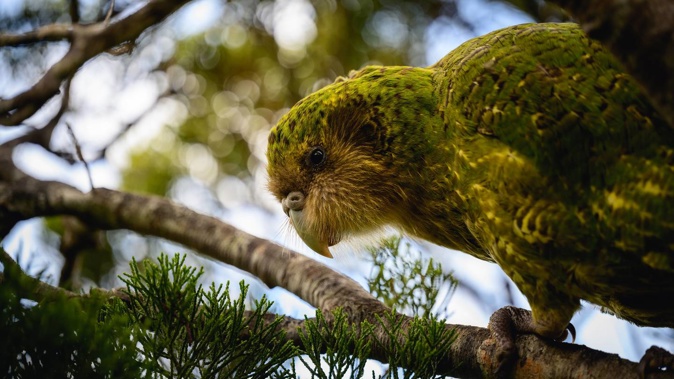
One of Waikato’s resident kākāpō has made an escape attempt from Sanctuary Mountain Maungatautari.
It is believed Tautahi, 4, who arrived in the region in September as part of a group of six, used a downed tree to boost himself over the fence and onto neighbouring farmland.
However, there is no reason for ruffled feathers: the flightless fugitive was safely returned to Maungatautari last week.
Tautahi is one of 10 kākāpō now living in Waikato as part of a habitat trial. All the birds wear backpack-style transmitters and GPS units that are regularly monitored by rangers, but there were some limitations to the technology.
This, combined with adverse weather and difficult terrain, prevented the team from pinpointing Tautahi for several days.
Sanctuary Mountain Maungatautari biodiversity team leader Dr Janelle Ward said those factors made it difficult to say how long exactly Tautahi was outside the fence.
/cloudfront-ap-southeast-2.images.arcpublishing.com/nzme/MNU5MJ3OAJCUJME6SYB4V2GTZQ.jpg)
Kākāpō males Manawanui (pictured), Elwin, Kanawera, Tautahi, Taeatanga and Manaaki moved to Sanctuary Mountain Maungatautari in September. Photo / Danielle Zollickhofer
“We definitely knew he was outside the fence on October 9 and we got him back safely within a couple of hours [on the same day]. We estimate that he was outside between a week and 10 days.”
Ward said she and the team didn’t spend much time worrying and went straight into problem-solving mode.
“We knew that he was still alive. If the bird was deceased, the transmitter would have sent a mortality signal which kicks in around 24 hours of the bird not moving.”
GPS data shows Tautahi spent time investigating the fence line, before going on a hīkoi (walk) through Pukeatua village, towards a farm block on the southeast corner of the mountain where he was intercepted by ranger team member Craig Montgomerie.
“Craig found him within two kilometres of the fence... Tautahi picked a big, rocky outcrop with nice views over the Waipa District and Waikato River.”
Sanctuary Mountain covers an area of 3400 ha, with 47km of predator-proof fence. Photo / Danielle Zollickhofer
Ward said by the time she and her team arrived at the location, Montgomerie had already captured the bird.
“Tautahi was not happy to have been caught. He was pretty grumpy when we did an initial health check at the scene to see if he was injured. But he didn’t have a scratch and it looks like he found enough food.
“We are thrilled he was well after his little adventure.”
Department of Conservation kākāpō operations manager Deidre Vercoe said while the departure from the sanctuary was not ideal, it was one of the expected challenges of the trial.
“Kākāpō have never lived in a fenced sanctuary before ... [They] are smart, determined and excellent climbers,” she said.
“The 2m-high, 47km-long fence underwent a modification ahead of the translocation to add a barrier to deter kākāpō from climbing it, however, as with any trial there is always an element of the unknown.”
Te Rūnanga o Ngāi Tahu Kākāpō species representative Tāne Davis said he was not surprised by the escape attempt.
“The manu (bird) will always challenge us ...They’ve spent their life on offshore islands with no fences, so it’s natural for them to be inquisitive.”
Sanctuary Mountain Maungatautari has made adjustments following the escape attempt, including vegetation clearances and increasing the monitoring of the birds.
Tautahi, alongside Elwin, Kanawera, Manawanui, Taeatanga, Manaaki, Bunker, Ōtepoti, Motupōhue and Māhutonga, were transferred from three islands off the South Island.
The translocation is part of a historic trial to see whether the nocturnal parrots can thrive in a fenced sanctuary, because the predator-free islands are close to capacity.
Sanctuary Mountain was chosen because at 3400ha, it is the largest predator-fenced habitat in the country.
The first group of four kākāpō was relocated in July as the second cohort of birds moved to the Waikato in September.
Overall, the 10 kākāpō are doing well in their new habitat, with all having passed recent health checks.
Vercoe said the feathered tentet had a period of settling in where they spent the first month exploring their new surroundings.
“Once they have the lay of the land, they tend to settle into their smaller ranges. Many of the others have come up to the fence and simply turned around again. So now we know we need to pay extra-close attention to the birds who spend more time investigating the fence.”
Ward added that more and more birds have moved into more permanent locations, with three of them still exploring “quite a bit”.
The team is also keeping a close eye on Ōtepoti, who was part of the first group of birds, because he is still “a bit light” having lost the most weight out of all birds, but within the normal range.
Stay up to date with the Waikato Herald
Get the latest Waikato headlines straight to your inbox Monday to Saturday. Register for free today - click here and choose Local News.
Take your Radio, Podcasts and Music with you

/cloudfront-ap-southeast-2.images.arcpublishing.com/nzme/BMFUKWORAFEX7NTLKSMDZUXEUE.JPG)








